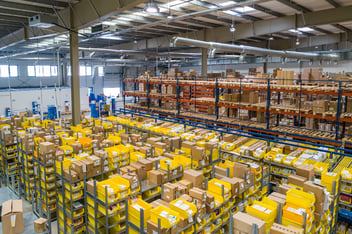How to Make Sustainable Logistics Happen: 10 Practices To Follow
Since the identification of 17 sustainable development goals (SDGs) by the United Nations, sustainability has become a cornerstone for many solutions in the business world, but instead of just talking about it, we're here to take action and if you're here, we have a feeling you are too. These SDGs are a global call to action to end poverty and protect the planet by 2030.
According to the Sustainable Practices in Logistics Systems report, “Sustainable development is the type of development that meets the current needs of the world without compromising the ability of future generations to meet their own needs.”
During the past few years, sustainable logistics has been researched by academics, organizations, and governments. Many companies have made it their strategic initiative and have worked on undoing the damage as well as preventing the future impact.
Before we discuss some best sustainability practices in the logistics industry, let's talk about what exactly sustainable logistics is.
What Is Sustainable Logistics?
The concept of sustainability in logistics operations can be defined as the promotion of sustainable procurement, transportation, packaging, distribution, reverse logistics, design, and control of sustainable supply chain operations.
Sustainable logistics aims to reduce the environmental footprint of shipping, such as CO2 emissions, noise pollution, and material waste.
As a business, sustainable logistics is a goal to draw a balance between financial growth while taking good care of the environment and the overall health of the planet we live on.
How to Make Sustainable Logistics Happen
Have you had a day where you expected five different delivery packages from different stores, all shipped overnight?
Have you ever questioned all of the packaging waste that comes with delivery packages?
Do you ever ask, 'Does it really have to be like this?'
Many businesses still haven't figured out how to make sustainable logistics happen. But customers are now ready to pay more if a company offers sustainable shipping.
So, do companies have what it takes to move toward sustainable logistics?
Maybe yes, or maybe no. How each logistics company achieves sustainability goals varies. Below, we’re sharing ten best practices as a roadmap for your sustainable logistics journey.
Top 10 Practices for Sustainable Logistics
1. Get a 360 View of Your Operations
To implement any change, awareness is the key first step. Assess your company's logistics operations to see where improvements can be made.
A comprehensive plan for sustainable logistics assessment should incorporate the following key elements:
- An in-depth evaluation of the social, environmental, and economic impact of the company's current operations and policies alongside future needs.
- Discussion of the long-term consequences or impact of the proposed change in addition to customer feedback on the new direction.
- 100 percent involvement and collaboration with all stakeholders throughout the entire supply chain.
2. Opt for Alternate Fuel or Electric Vehicles
While no shipping method in the world is devoid of carbon emissions, there are better alternatives to 'reduce' the impact than traditional gas-guzzling vehicles.
If not the best, electric or alternate fuel vehicles are the most environmentally friendly way to ship.
Not only that, but the carbon emissions produced by the distribution facilities can also be reduced via clean energy-powered electricity, solar systems, and water recycling systems.
Look for logistic companies that have a sustainable fleet with electric vehicles or alternate fuels to take a step further toward your sustainable logistics goal.
3. Work on Route Optimization and Planning
Another good sustainable logistics practice is ensuring that your fleet routes are optimized based on order numbers, location, delivery times, temperature, and other conditions.
Route optimization minimizes the travel distance for vehicles and reduces possible congestion and idle time.
4. Optimize Your Supply Chain
Sustainable supply chains lead to sustainable logistics operations. It’s essential for businesses to optimize their supply chain across all three pillars of sustainability (society, economy, and environment) when making a logistics operation decision.
An optimized supply chain means effectively planning activities to utilize on-site resources and avoid manufacturing and packaging waste, transport and labor costs, and of course, to reduce carbon emissions.
5. Discourage Fast or Overnight Shipping
Fast, free shipping has an environmental cost that is 'costlier' than many businesses realize. The more time you have to ship the product, the more efficiently you can optimize the delivery routes and manage the load on your vehicles.
To put this dilemma into perspective, with one delivery per trip, the carbon emissions can be as much as 35 times greater than they would be for a fully-loaded delivery truck. Three to five-day delivery is a good standard practice that businesses should follow to minimize its adverse environmental impact.
6. Use Marketing Messaging to Create Awareness
Consumers' understanding of the problem is extremely important to introduce positive change, and for that, businesses need to create awareness about sustainability through their platforms and marketing messaging.
Here are some ideas:
- Run awareness campaigns through social media advertisements encouraging consumers to opt for green checkout (more on this in the next section).
- Build a community of followers who believe in the same mission and encourage them to act as a catalyst for change.
- Introduce discounts on sustainable shipping and spend your marketing dollars promoting sustainable packaging materials.
- Sponsor local and global events that promote sustainability and participate in dialogues to show your stance as a business.
- Show your impact numbers to create transparency and highlight that you walk the talk.
7. Introduce Green Checkout
Another important sustainability practice is to introduce green checkout on your website. Many businesses think that all customers want is faster shipping, and if they can’t make it happen, they'll lose them, but it's not completely true.
As the world becomes more aware of environmental impact and the damage caused by greenhouse gas emissions, customers are now starting to choose the planet over convenience.
During the UN Climate change conference, it was shared that "While attitudes vary across generations, countries, and industries, 85% of consumers have become ‘greener’ in their purchasing in recent years."
The call to action to bring sustainable shipping methods to your logistics operations through incentives like green checkout has never been louder.
8. Get Big on Big Data
Data shares insights that no human can. If you place data at the heart of your sustainability practices, you’re already one step ahead toward your sustainability goals.
Data analysis allows you to optimize routes based on traffic congestion, infrastructure blocks, or customer availability. It also eliminates the risk of empty mileage by loading vehicles to optimum capacity, which is both environmentally and cost-friendly.
Real-time tracking also allows you to monitor the fleet and identify the best alternatives without wasting time, money, and resources.
9. Enroll in the SmartWay program
If you’re not aware of it, The SmartWay Partnership is a free program in Canada that helps businesses ship goods efficiently while keeping fuel costs and environmental impact at a minimum level.
Logistics companies that have acquired SmartWay Certification in Canada and the US have saved billions of dollars and reduced their carbon emissions drastically.
The program was started by the United States Environmental Protection Agency (EPA) but has been run in Canada by Natural Resources Canada (NRCan) since 2012.
More than 3,600 North American companies have signed on to the partnership. You can visit the Join SmartWay page to see if you qualify as a partner or affiliate.
10. Use Technology to Implement Efficient Processes
There are many ways technology can contribute towards your sustainable logistics goals. Businesses that build tech-first policies and logistics software and systems can leverage it for the following benefits:
- Smart delivery through logistics software mitigates any risks of empty miles and quickly adapts to any changes in the supply chain.
- Real-time tracking at every step helps you optimize routes, increase fuel efficiency, and manage delivery schedules.
- Reduce manual paperwork and automate supply chain operations through electronic proof of delivery, alerts, e-invoicing, etc.
- Use AI and IoT sensors to monitor and collect data on speed, fuel consumption, and driving patterns.
Wrapping Up
Sustainability isn’t a one-time gimmick or a fad; it’s a long-term commitment that starts with a deeper understanding of the issue and requires taking consistent steps to prevent damage.
At Ziing, our logistics solutions are intelligent, efficient, and sustainable every step of the way. We’re building a full-proof delivery ecosystem that puts sustainable operations first and fosters a national network of knowledgeable, verified local companies and drivers.
Companies work with us to save capital, harness the power of data-driven insights, and accelerate their positive impact on the environment.
Get in touch to see how we can help you achieve your sustainable logistics goals while growing your business at your pace without the need for large capital. We're ready to make the change. Who's with us?






